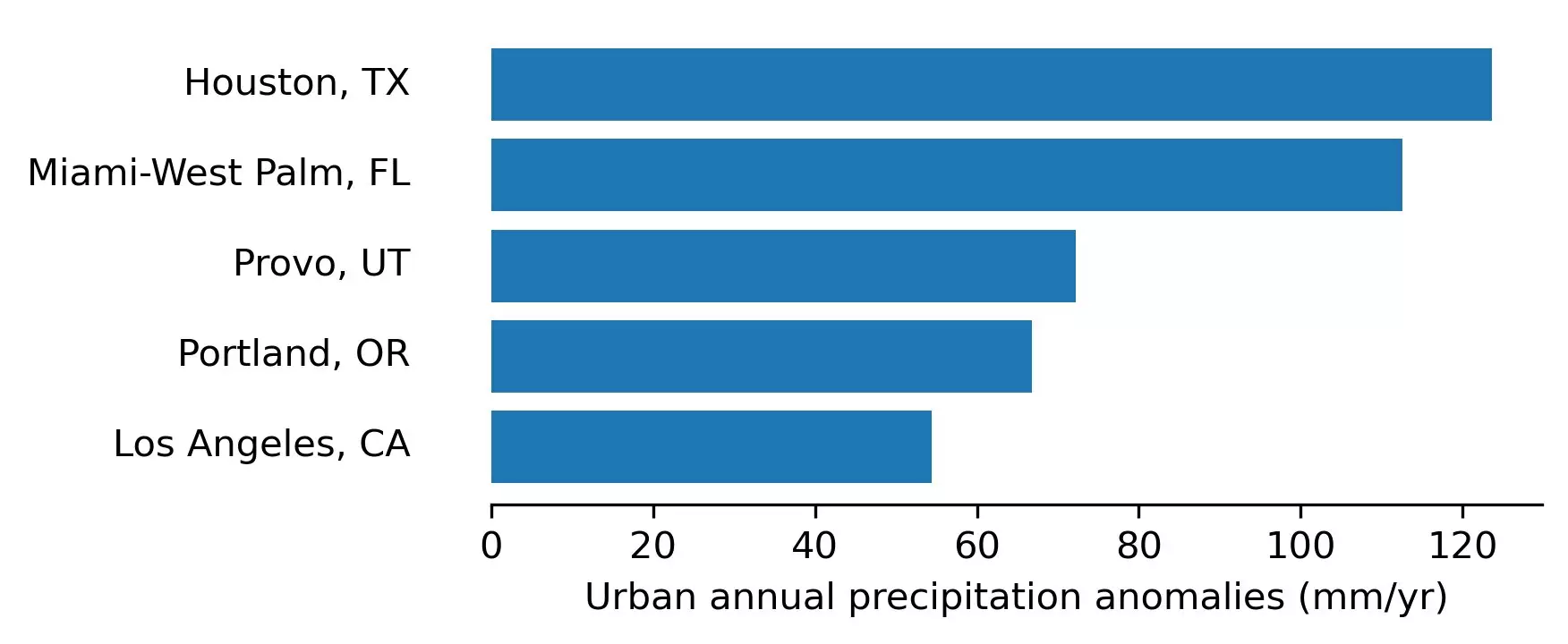Urbanization is a powerful force that shapes not only the physical landscape but also the climate of the areas it occupies. While most are familiar with the urban heat island effect—where city regions become significantly warmer than their rural counterparts—the lesser-known urban precipitation anomaly presents another layer of complexity. This phenomenon reveals that urban regions can impact rainfall patterns, leading to increased precipitation in cities compared to their nearby rural areas. A recent study conducted by researchers from The University of Texas at Austin sheds light on this issue, examining precipitation anomalies in over a thousand cities worldwide.
In their comprehensive study, the researchers analyzed meteorological data from 1,056 cities around the globe, spanning the years 2001 to 2020. The results were striking: more than 60% of these urban areas receive higher annual rainfall than the corresponding rural locales surrounding them. In particular, cities such as Houston, Texas, emerge as significant outliers, witnessing an average of nearly five additional inches of rain annually. This uptick in precipitation can have dire consequences, especially in urban environments where infrastructure may struggle to manage increased water runoff, thereby elevating the threat of flash floods.
Despite previous knowledge surrounding localized precipitation anomalies, this extensive global analysis marks a pivotal moment in understanding how cities can fundamentally alter rainfall patterns. Study co-author Xinxin Sui emphasizes the significance of their findings, noting that earlier research often focused on specific cities or unique storm events, omitting a broader landscape perspective.
An intriguing aspect of the research is its examination of how various climate zones influence the degree of precipitation anomalies in urban areas. The study found that cities located in hotter and wetter climates tend to experience greater anomalies than those situated in cooler and drier regions. This link suggests that climate, quite profoundly, governs how urbanization interacts with natural precipitation processes. Moreover, cities in regions like Ho Chi Minh City, Vietnam, Kuala Lumpur, Malaysia, and the Miami metropolitan area demonstrate considerable rainfall differences, underscoring the role of local climate conditions in shaping urban weather patterns.
This urban precipitation anomaly can be compared to the mechanics of a sponge—it can absorb rainwater in one location and release it more violently in another. Just as a sponge when pinched causes water to squirt from a specific point, urbanization may alter where and how rain falls, transferring precipitation from broader areas and concentrating it within city limits.
Several physical factors contribute to the urban precipitation anomaly phenomenon. Tall buildings play a significant role, creating barriers that block and slow wind currents, leading to air convergence at city centers. This phenomenon further enhances upward air movement, crucial for condensation and cloud formation, thus effectively increasing the potential for rainfall.
However, the dynamics are not uniform across all urban areas. In some cases, notably in cities nestled in valleys or regions with adjacent mountains, urban landscapes may experience reduced rainfall compared to the rural surroundings. This is evident in cities like Seattle, Washington, and Kyoto, Japan, where geographical features can dictate precipitation patterns, leading to anomalies that deviate from the expectations established by other urban areas.
Interestingly, population density emerges as the most significant correlate with urban precipitation anomalies. A higher population leads to denser and taller urban structures, which, combined with increased greenhouse gas emissions, enhances the urban heat effect. This dynamic creates a feedback loop where warmer urban environments encourage more precipitation, further intensifying existing rainfall patterns.
The interplay between urbanization, population density, and climatic conditions forecasts a future in which urban areas must grapple with the consequences of increased precipitation. As urbanization continues, particularly in the face of climate change, cities will need to innovate in managing stormwater and preparing for extreme flooding events.
The implications of this phenomenon necessitate a reevaluation of urban infrastructure and planning policies. As urban areas become more susceptible to flash flooding, innovative techniques for stormwater management will become essential. Urban planners must prioritize green spaces, permeable surfaces, and advanced water retention systems that not only mitigate flooding risks but also enhance urban resilience.
The urban precipitation anomaly demonstrates the complex interplay between urbanization and climate. With ongoing urban expansion and the looming threats of climate change, understanding how these factors coalesce to influence rainfall is more crucial than ever. Cities must prepare for these challenges to ensure sustainable living conditions for their citizens, transforming potential crises into opportunities for innovative urban design and community resilience.

